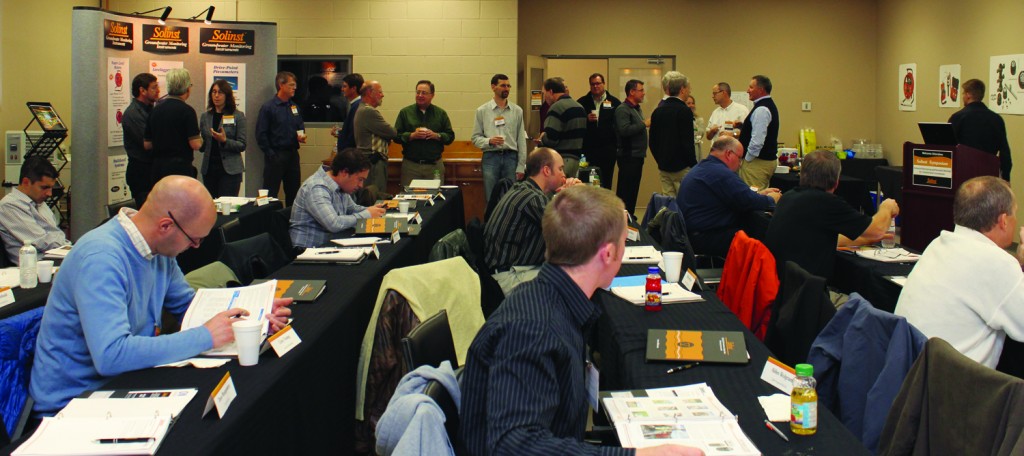On November 7, 2013, we held our fourth “Solinst Symposium” here at our facility in Georgetown, Ontario, Canada. The Symposium theme was “High Resolution, Depth-Discrete Groundwater Monitoring – Benefits & Importance”.

Networking at a Previous Solinst Symposium
The Symposium had a new one day format that featured speakers from prominent educational institutions, as well as internationally noted consulting firms. Their talks focused on the latest research and methods for high resolution subsurface monitoring and measurement, and included specific applications and case studies.
The event was kicked-off with an introduction from Dr. Gary Wealthall of Geosyntec Consultants. He discussed the “History of the Evolution of High Resolution Tools and Methods for Groundwater Monitoring”.
The Symposium continued with a presentation about “Hydraulic Testing in Fractured Sedimentary Rock for Contaminant Hydrogeology Studies,” from Dr. Patryk Quinn of the University of Guelph.
Next, Dr. Richard Amos with the University of Waterloo discussed the “Diavik Waste-Rock Research Project: High Resolution Gas Pressure and Concentration Monitoring.”
Following that, Dr. Kent Novakowski with Queens University presented his talk on “Developing Conceptual Models for Flow and Transport in Bedrock Aquifers Using Depth-Discrete Hydraulic and Tracer Transport Measurements.”
Dr. Jessica Meyer, with the University of Guelph concluded the talks with a discussion on “A High Resolution Vertical Gradient Profile Approach for Delineation of Hydrogeologic Units at a Contaminated Fractured Sedimentary Rock Field Site.”
Refreshment breaks and lunch were provided, which offered great networking opportunities for attendees.
At the close of the Symposium, a round table discussion was held to encourage open discussion between all attendees and speakers participating in the Symposium. The round table discussion was moderated by Gary Wealthall, who as a consultant and educator, has extensive knowledge and experience in the area of high resolution monitoring.
As was the theme of the Symposium, the benefits and importance of these high resolution methods and techniques were thoroughly presented during these talks. Although many, including us at Solinst, are well aware of the benefits, there are still some barriers to more widespread use of these tools.
This leads to many questions: What are the major barriers to using high resolution monitoring methods/instruments? Are high-resolution tools and methodologies being used appropriately? What is required to increase the use and understanding of these technologies? Where is the industry headed?
With all these questions about high resolution, depth-discrete groundwater monitoring, it definitely led to a very interesting round table.
To view the full Symposium agenda, including speaker bios, as well as other conference highlights, please visit: http://www.solinst.com/Symposium/Symposium2013/
